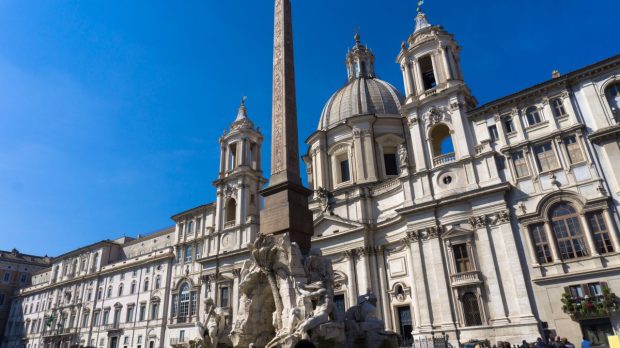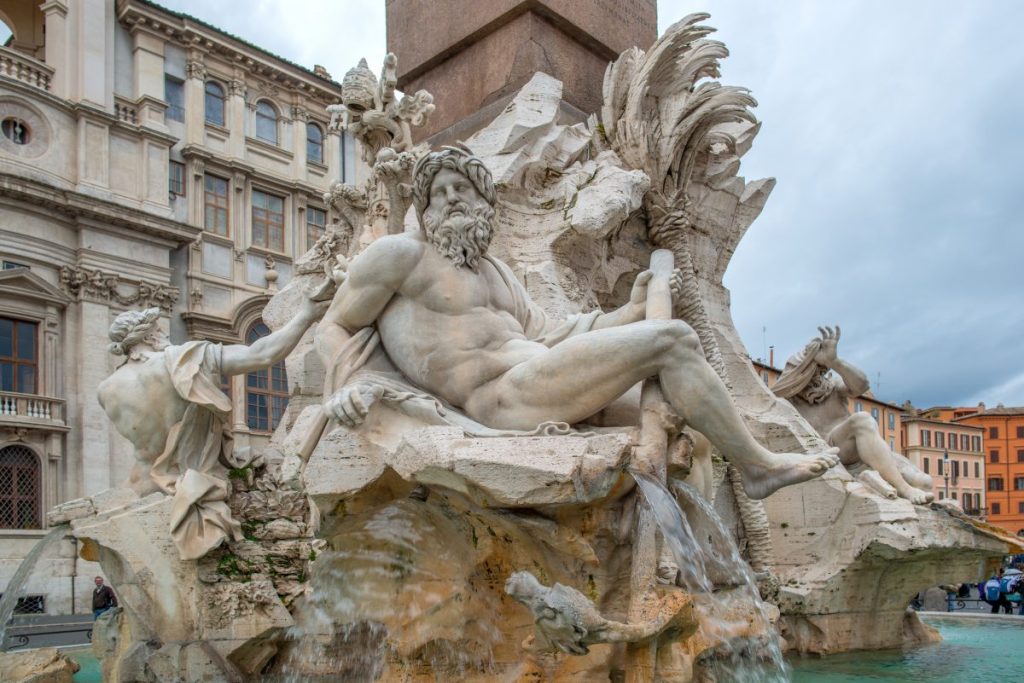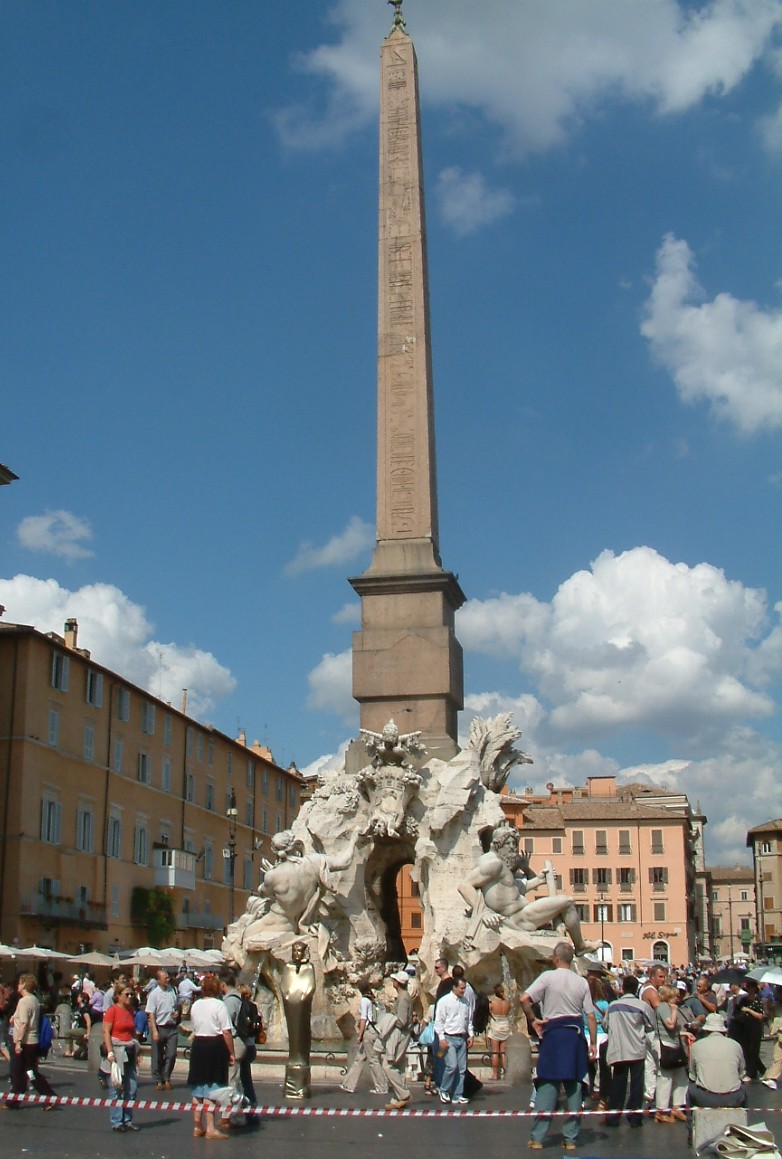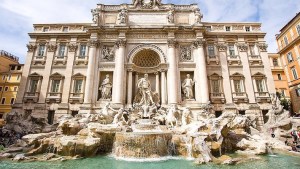Situated in the center of Piazza Navona, this monument is famous the world over. Known as the “Fountain of the Four Rivers,” it was commissioned by Pope Innocent X from the sculptor and architect Bernini, who completed the work in 1651.
A combination of elements
In front of this firework display of water jets, thousands of tourists come every day to contemplate four statues clinging to baroque rock work, the muscular incarnations of four of the world’s great rivers: the Danube, the Ganges, the Nile, and the Rio de la Plata.
The gaze of the passer-by is drawn to the lapping of the water and the remarkable expressions of the allegories. But, as is often the case in Rome, you have to look up to see fully what’s going on. Indeed, at the Pope’s request, Bernini placed a huge obelisk above the structure, and it has a particularly unusual history.
If you start at the top of the monolith, you’ll find—as is often the case in Rome—a bronze cross surmounting the pagan construction. Below the cross, the artist has depicted a dove with an olive branch, the coat of arms of the Pamphili family to which Innocent X belonged.
Thanks to this monument, this pope belongs to the family of “pharaoh popes” who decided to highlight the Egyptian heritage present in Rome. Like him, Sixtus V (1585-1590), Alexander VII (1655-1667), Clement XI (1700-1721), Pius VI (1775-1799) and Pius VII (1800-1823) installed one of the 13 obelisks located in the city.
The construction of the fountain, which was extremely costly, did not please everyone. The people of Rome made their opinion very clear by leaving this Latin inscription on the monument: “Dic ut lapides isti panes fiant,” which means, “Command these stones become bread.”
Why an obelisk?
By restoring the obelisks, the popes were reviving the prestige of the emperors of yesteryear, and proclaiming themselves defenders of a universality capable of encompassing all cultures, even the pagan cultures of yesteryear. It was this consideration, nourished by the humanist thinking of his time, that led to the creation of the Vatican Museums by Pope Julius II in the 16th century. Lastly, there was the fascination for Egyptian “mysteries” that fed the curiosity of many erudite minds in those days.
To set up once more the obelisk in Piazza Navona — also known as the “agonal obelisk” — Bernini’s workshops had to restore the monument’s four granite faces, which had fallen into disrepair. This applies to its “pyramidion,” the pyramid-shaped tip of the obelisk. To this end, a certain Athanasius Kircher was called in. He was a scholar nicknamed “the last man who knew everything,” but who of course knew very little about hieroglyphics. He nevertheless completed certain fragments.
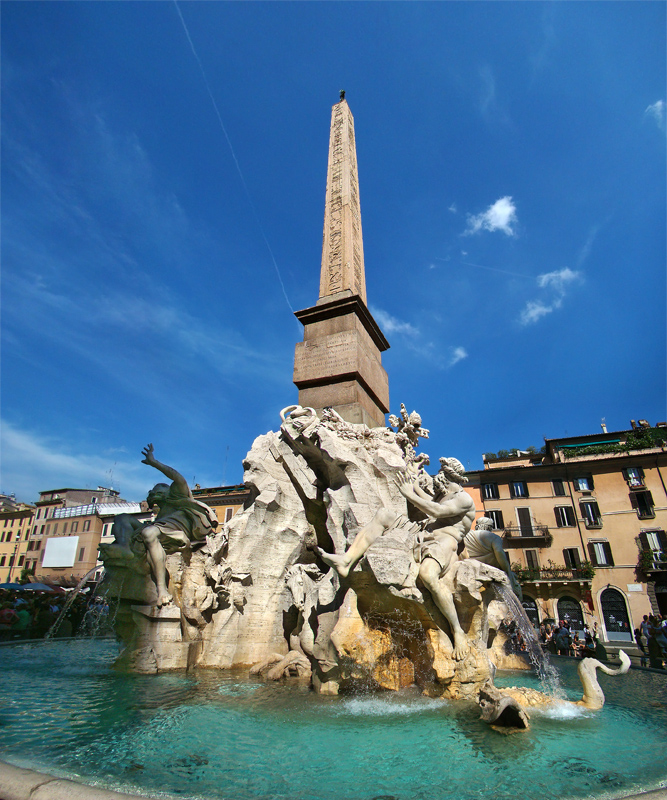
These inscriptions, translated in the 20th century, reveal an astonishing fact: this obelisk, although carved in Egypt and transported to Rome, was designed at the request of the Roman Emperor Domitian, and not salvaged from the remains of the Egyptian kingdoms. Italian Egyptologist Nicola Barbagli pointed out at a conference organized by the Vatican Museums that the hieroglyphs were therefore written for the Roman ruler, but were clearly inspired by the way the pharaohs of yesteryear were described.
The Rome-Egypt connection
Domitian, a first-century emperor, was in fact personally linked to Egypt, a territory that had belonged to the Roman Empire for almost 100 years. His father, Emperor Vespasian, had learned that he was to become emperor in 69 while praying in the Temple of Serapis in Alexandria. The circumstances of this episode are strange, and, according to one chronicler, involve miracles.
As emperor, Vespasian held authentic piety, mingled with magical beliefs, for gods such as Isis and Serapis, which he passed on to his successors Titus (79-81) and Domitian (81-96). For the people of Egypt, the emperor was considered a pharaoh at the time, despite the end of the Ptolemaic dynasty with the death of Cleopatra in 30 BC, and Domitian seems to have been particularly aware of this responsibility and its spiritual implications.
In one monument, history thus bears witness to the prestige of a builder and humanist pope, the esoteric piety of an emperor, and the persistence of the pharaonic lineage in ancient Rome.
The original pyramidion, as well as many original fragments of the faces, are now in the Vatican Museums’ storerooms.
